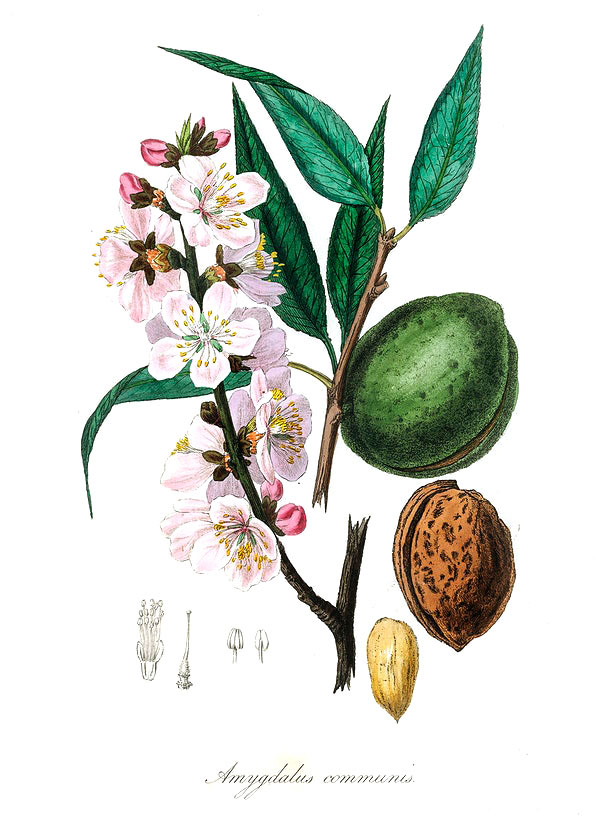Almond

Origin: Iran & surrounds
Family: Rosaceae
Scientific Name: Prunus amygdalus Batsch
Folk Names: Almandre, Almendro, Amyllier, Bitter Almond, Greek Nuts, Sweet Almond
Magical
Element: Air
Day: Friday
Planet: Mercury
Zodiac: Gemini
Associated Celebrations: VernEx
Deities: Attis, Hermes, Jupiter, Mercury, Phyllis, and Zeus
Parts used: Nut (seed)
Magical Properties: Money, love, fertility, divination, prosperity, wisdom
Substitutions: Any other tree nut
Lore
In Iran, almonds were used to cure insomnia, to stimulate lactation in breastfeeding mothers, to relieve headaches, and to guard against the evil eye.
In Greek mythology, the god Attis was said to have been born of an almond.
In the Late Medieval Mediterranean, almonds were an important commodity. The Knights Templar required almonds as tithes, and almond branches were the rod of choice for medieval magicians, as well as for use as divining rods in Tuscany.
Throughout Europe, almonds were believed to be symbols of good luck, and were given as weddings for long life and happiness. Candied almonds are still a traditional gift to guests at Italian weddings.
Magical Uses
- Eat almonds or almond-based foods to bring money into your life.
- Placing almonds in your pocket is supposed to lead you to treasures.
- Climbing an almond tree is said to ensure a successful business venture.
- In some traditions, air is the elemental ruler of the magic wand, making almond a favoured wood for wand-making.
- Almond is gentle and kind, and great for spellwork relating to children and their innocence, as well as love spells geared towards a gentle, innocent first love.
- Almond is associated with cycles and beginnings through the myth of Attis. This makes it a powerful carrier oil for blends concerning spring, and renewal or change.
Aromatherapy
Part Used: Nut kernel
Extraction Method: Cold-pressed
Flash Point: 280°C
Perfume Use: Base oil
Shelf Life: 9-12 months
Scent Description: Faintly almond, nutty
Active Constituents: Rich in oleic acid (64-82%)
Aromatherapeutic Uses
Almond oil is a non-greasy, moisturising, softening, and soothing oil, when used on the skin. It is absorbed well, but not too quickly.
Almond oil is a good base for massage and anointing oils.
Topical Use
Skin Types: All
Absorption Rate: Medium
Viscosity: Medium
Properties: Emollient, skin softening, boosts immune function of skin, anti-inflammatory, healing, improves skin tone.
Warnings: Likely to cause a reaction in those with nut allergies.
Practical
Culinary
As well as being eaten as itself (raw or toasted), almond is the core ingredient in a number of food and beverages. It is also used to make products such as almond butter, flour, and milk.
Almond is a core ingredient in marzipan, nougat, macarons, as well as many other baked goods and desserts.
Beauty
Sweet almond oil is frequently used in cosmetics, and as a carrier oil in many different applications.
Botanical
Type: Deciduous tree
Plant size: 4-10m
Bark: Purple/green, fading to grey
Leaves: 8-13cm long, 2.5cm wide, with serrated edges.
Flowers: Djilba: White/pale pink, 3-5cm across with 5 petals
Fruit: 3-6cm long, green downy fruit, with a leathery flesh, with a hard hull in the centre protecting a seed (nut).
Etymology: From the Greek word amygdale, meaning ‘almond’. The amygdala (in the brain) is named for its almond-like shape.
In the Garden
Type: Tree
Plant: Winter
Light: Bright light
Soil: Rich, light soil, with lots of organic matter
Companion Planting: Clovers and other legumes contribute to soil fertility and attract pollinators.
Tips:
- Incorporate plenty of well-rotted organic matter when planting.
- Hole to plant trees into should be wider rather than deeper.
- Mulch after planting.
- Protective cage or pipe around the trunk may be required to protect the young tree from pests.
- Apply a generous amount of compost in spring, along with organic fertiliser.
- Where only 1 or 2 trees are grown, it may be best to hand-pollinate.
- Ensure an appropriate variety is chosen for your climate: blossoms can be prone to cold damage.
- Almonds begin fruiting in their 3rd year, and reach full bearing 5-6 years after planting. Healthy trees will bear fruit for 10-15 years.
- Harvest in late summer (7-8 months after) flowering, when nuts begin to drop.
